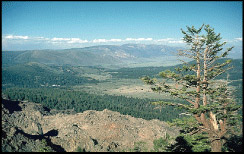
Project Title: Ground Deformation and Magmatic Processes in Long Valley Caldera, California
Mendenhall Fellow: Stephanie Prejean, (650) 329-5083, sprejean@usgs.gov
Duty Station: Menlo Park
Start Date: March 3, 2002
Education: Ph.D. 2002, Stanford University, Geophysics (specializing in seismology and tectonophysics)
Research Advisors: David Hill, (650) 329-4795, hill@usgs.gov; John Langbein, (650) 329-4853, langbein@shasta.wr.usgs.gov; Malcolm Johnston, (650) 329-4812, mal@usgs.gov
Project Description: An essential component in understanding the processes driving caldera unrest involves accurately defining and tracking the spatial-temporal evolution of caldera deformation and interpreting the physical process driving both seismic and aseismic deformation. Most published models for the dominant episodes of accelerated deformation during this period are the result of different investigators using different approaches, assumptions, and limited combinations of the available data. Thus as things currently stand, we are left with no consistent basis for understanding how source geometries and processes have evolved with time as caldera unrest has developed over the past two decades.

|
Schematic southwest-northeast geologic cross section of the Long Valley Caldera, showing likely locations of magmatic injection. (Courtesy of R. A. Bailey.) |
| The focus of this research is to develop a consistent set of both seismic and aseismic deformation models for Long Valley caldera spanning the entire period of unrest from its onset in 1978-80 through 2000 merging as much of the available data as possible (seismicity, EDM, GPS, leveling, strain, tilt, and water level change data). The scientific dividends from this work include not only a coherent space-time record of caldera deformation and the associated physical processes, but also a solid foundation for interpreting future episodes of accelerated deformation in the caldera as they occur. Variations in seismicity and deformation, can be used to distinguish between deformation resulting from phase changes and local mass increases associated with magma intrusion. The difference, of course, carries important implications for volcanic hazards. |
 A view of the Long Valley Caldera from its northwestern rim
toward the southeast. The rim of the caldera is visible, as well as the caldera's resurgent dome, located in the center of the caldera. The resurgent dome is the dark green, tree covered hill in the far right portion of the photo. (Photograph by S.R. Brantley.)
A view of the Long Valley Caldera from its northwestern rim
toward the southeast. The rim of the caldera is visible, as well as the caldera's resurgent dome, located in the center of the caldera. The resurgent dome is the dark green, tree covered hill in the far right portion of the photo. (Photograph by S.R. Brantley.)
|
|
|
Previous Profile | Project Profiles | Next Profile |
|
<URL:http://geology.usgs.gov/postdoc/profiles/prejean.html>
Maintained by: Eastern Publications Group Web Team
Last updated 21-August-2002 (krw)